Samsung Galaxy Note 3 Review
by Brian Klug on October 1, 2013 9:00 AM EST- Posted in
- Smartphones
- Samsung
- Mobile
- Android 4.3
- galaxy note 3
Cellular and WiFi
With the advent of MSM8974 comes the third generation of Qualcomm’s LTE modem, in this case what 8974 brings over the second generation is new Category 4 LTE (up to 150 Mbps on the downlink) over the previous generation’s Category 3 maximum, 3GPP release 10 carrier aggregation, up to 3 carriers of HSPA+ aggregated, and of course the requisite CDMA 1xAdvanced/EVDO, GSM/GPRS/EDGE.
Of course it’s up to each operator and handset maker to make their own decision regarding what features they want implemented via the choice of frontend RF components, and in the case of the Note 3 those insights will really have to wait until someone tears one down. I suspect however that with the Note 3 Samsung marches even closer to a single worldwide SKU or at least fewer SKUs for each region. In the case of the T-Mobile Note 3, there’s disclosure for the banding that I would expect in the FCC documents, Bands 2, 4, 5, and 17 LTE are supported, at minimum, I wouldn’t be surprised to see 7 and 20 also supported in the same hardware. I strongly suspect we’re looking at a situation similar to the SGS4 where there was shared platform and front end between AT&T, T-Mobile, and Canada. I haven’t had time however to go through and look at all the Note 3 variants and their banding, and as usual Samsung doesn’t disclose their band combinations up front.
Without 20 MHz FDD LTE to test on T-Mobile, there’s not much we can really say about Category 4 in the context of the Note 3 review. In other markets with 20 MHz FDD LTE however this will open up additional throughput headroom that some already are up against.
The Note 3 continues to have Samsung’s great ServiceMode option for looking at signal characteristics like RSRP, channel bandwidth, and forcing whatever bands you want. However Samsung did remove the unlock shortcuts that were popularized for the previous Galaxy S series and Notes through the debugging screens and phone control menu. This also happens at the same time Samsung has started region locking devices.
As devices move closer to being truly universal with more LTE bands, I wouldn’t be surprised to see more of this kind of arbitrary locking being used to keep operator verticals in place and protect markets.
I had no issues with the Note 3 in both 5 MHz FDD LTE markets like NYC where I did some of my testing, and my home market in Arizona which is 10 MHz FDD LTE on T-Mobile.
Antenna placement on the Note 3 is pretty pragmatic as well, at least on this variant. One big main antenna for transmit on all the bands supported by the hardware, and a second diversity antenna for LTE and WCDMA.
A big new thing in the Note 3 is the inclusion of a component from Qualcomm’s RF360 portfolio, the QFE1100 envelope power tracker, making it the first device to do so. This reduces overall thermal footprint and power consumption on the RF front end by varying the voltage across the power amplifier (which previously was a fixed DC voltage) to match the waveform of the transmitted signal. The envelope tracker essentially is a power supply with a closed loop between the baseband and the power amplifier, which enables the power amplifier to closely follow the desired transmitted waveform. Envelope trackers help mitigate the power waste that comes with high peak to average power ratio inherent to OFDMA (LTE) by closely matching the power amplifier voltage supply to the output signal. This allows the power amplifier to work much closer to the peak of its power added efficiency (PAE) curve, especially when the input signal envelope is low, by tracking the amplitude of the input signal.
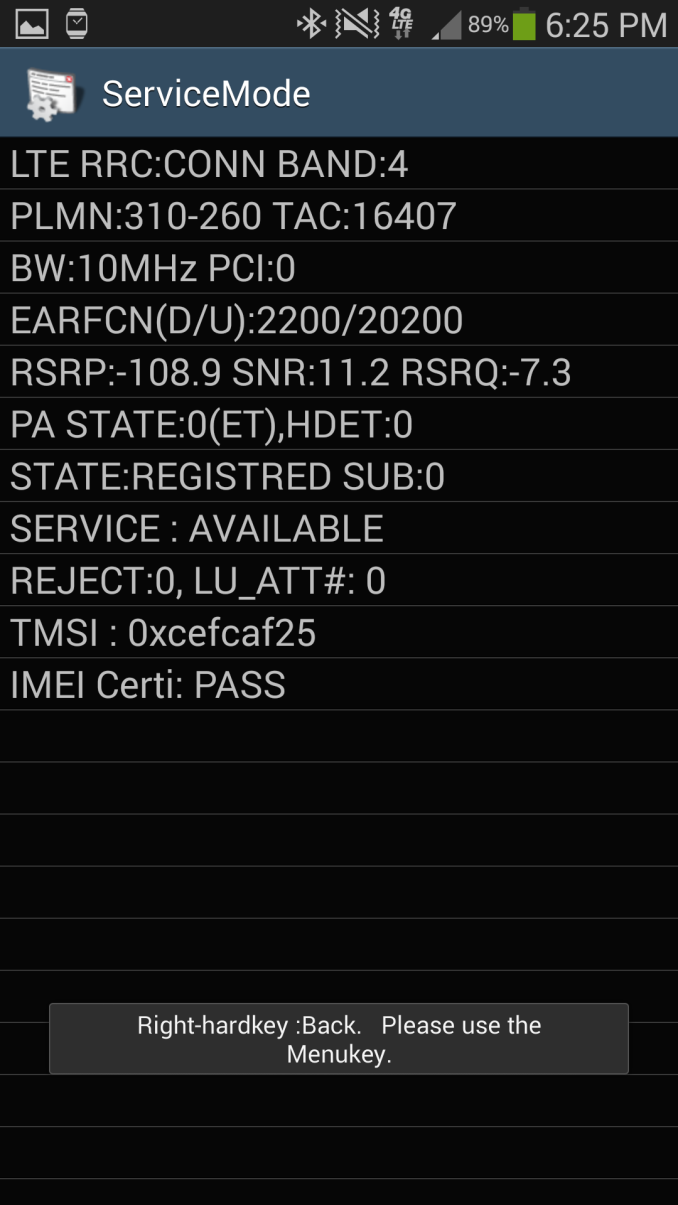
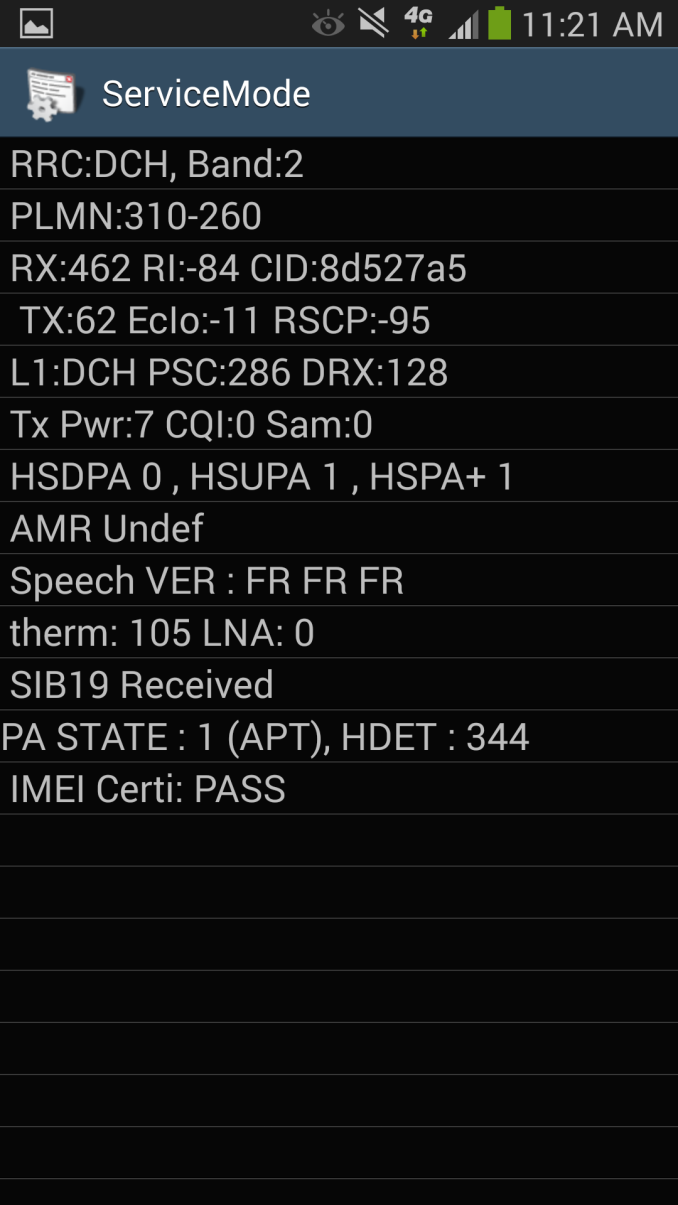
ET (Envelope Tracking), and APT (Average Power Tracking) on Note 3
Watching ServiceMode on the Note 3 is a real treat since you can see PA State change between a few different modes, APT/PT/ET which I suspect translate to average power tracking, power tracking, and envelope tracking modes, again confirming the presence of the power tracker. Qualcomm has a post up about the QFE1100 and its use in the Note 3.
GNSS
With 8974 also comes another newer version of Qualcomm’s GNSS (Global Navigation Satellite System) software suite. The previous generation (GNSS Gen 8/8A) included support for GPS and Russia’s GLONASS system. The new one onboard 8974 and forward moves to GNSS 8B which includes support for GPS, GLONASS, and China’s Beidou constellation.
At present there’s no way for me to validate whether Beidou support is working on any of the 8974 phones I have, because the coverage for that constellation is not global but rather limited to a slice in the Asia-Pacific region. I’m not aware of any other improvements inside GNSS 8B, but Qualcomm’s GNSS has always been excellent for me, locking quickly even indoors or in urban canyon scenarios. The Note 3 performs very well and locks quickly and I don’t have any issues to speak of.
WiFi
I didn’t expect much to change on the Note 3 from SGS4 in terms of WiFi connectivity, but I got an interesting surprise. Instead of the BCM4335 combo which was ubiquitous in this last round for WiFi/BT/FM radio, there’s the newer generation BCM4339 combo which integrates the necessary power amplifiers and front end components for a lower cost solution.
BCM4339 is still a single spatial stream part with support for 802.11a/b/g/n/ac, and on 802.11ac support for up to 80 MHz channels with 256QAM under MCS9, for a PHY rate of 433.3 Mbps, which is what we’ve seen before with 4335. Again what’s new is the integration of the 2.4 and 5 GHz power amplifiers for transmit and low noise amplifiers the receive chain, as well as the other necessary front end components, although handset makers can still choose to support their own external ones. This drives integration cost down and hopefully means 802.11ac will find its way into more places.
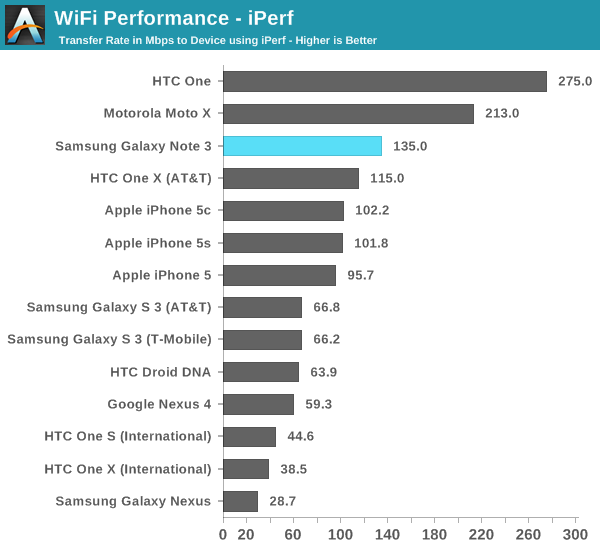
I tested the Note 3 using iPerf the same way I have other phones for a while now and saw some weird behavior. WiFi throughput during my test jumped around quite a bit and even on the 433 Mbps PHY rate the maximum sustained rate I could get was around 135 Mbps. Still very fast, but not quite up as high as some of the other 802.11ac phones I’ve tested.
I don’t like that there’s no band preferences option under the advanced menu anymore, although this seems to be a thing operators want removed (which makes no sense to me, but whatever). The Note 3 does add an auto network switch toggle which seems to be a feature Qualcomm has added to its BSP lately to allow for intelligent switching between WiFi and cellular when the WiFi network you’re attached to isn’t delivering any packets. I also noticed that the Note 3 will shut down the data session for cellular when you’re attached to WiFi as well to cut down on power use, something a few other vendors have done for a while.
Speaker and Noise Rejection
With the Note 3, Samsung changes up the normal speakerphone location dramatically, from the back side coming out of the battery cover to a new place blasting out the bottom lip of the Note 3 through a grille. I tested speakerphone on the Note 3 the same way I have other devices, by placing a call, cranking volume up to maximum, and using a data logging sound pressure meter to record and average the entire call.
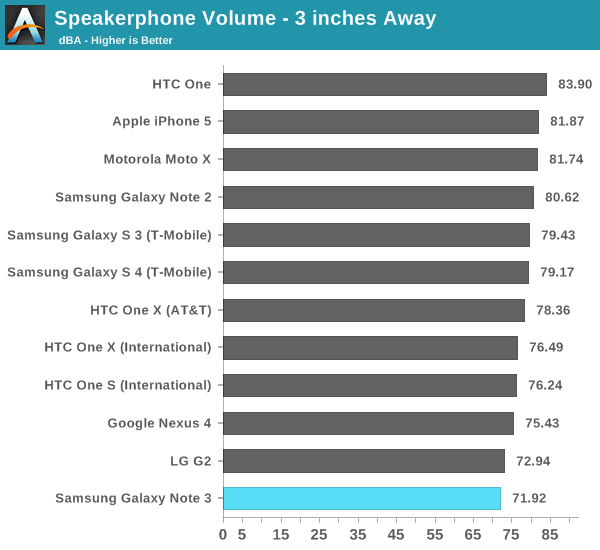
Oddly enough, speakerphone is very quiet on the Note 3 and isn’t nearly as loud as SGS4. More puzzling, tapping the extra volume button doesn’t seem to do anything at all if you’re attached to WiFi, however the button works if you’re not attached to WiFi (and thus the background data connection is enabled). This seems like a bug to me, as it’s very quiet compared to the competition, and unfortunate since part of the Note 3 is that expectation of a great multimedia experience with the big display.
A big change in the Note 3 is the inclusion of a new generation of Audience voice processor, the Audience eS325 which we’ve talked about before, which includes support for using three microphones for ambient noise reduction. Interestingly it turns out the SGS4 had 3 microphones and this same solution, but only ever used them in pairs (the third was next to the earpiece and only used during speakerphone calls). The Note 3 has three very visible microphones, one at top, one at bottom, one on the bottom right side.
Audience enables noise reduction on narrowband (8kHz), wideband(16kHz), and super wideband (24kHz) calls with this new generation with the three microphones. This new solution also adds de-reverb which helps reduce the reflections audible when calling from an enclosed room, something the previous generation didn’t have.
To test I ran through the same test we’ve done in the past, I speak into the handset in front of speakers playing a babble distractor track up to a certain sound pressure level, and then back down. I added in a speakerphone mode (far talk) mode as well just for comparisons, with the noise reduction toggle that Samsung makes available in the phone dialer toggled on and off, for comparisons. I called between a T-Mobile Galaxy S 4 and the Note 3 on T-Mobile, which gave us 12.65 kbps AMR-WB (“HD Voice”) voice call, in a spectogram of the recording we can also see components above the 4 kHz filter for a normal narrowband voice call (narrowband is again 8 kHz sampling, AMR-WB uses 16 kHz sampling, after nyquist we pass 4 kHz and 8 kHz respectively).
The eS325 does a good job rejecting the babble track without rejecting a lot of the incoming voice or making me sound distorted. I’m always impressed that anything is audible at the maximum volumes as these are literally so loud I can’t hear myself talking into the handset and probably not conditions normal people would call under anyways. Noise rejection on these larger phablet or Note sized phones is also a challenge since the microphone pairs are far apart and the mouth is physically further from the microphones than they normally would be, so I’m impressed with overall performance considering those constraints.


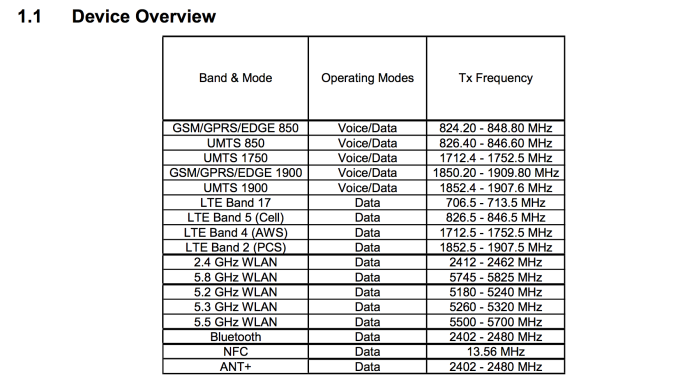
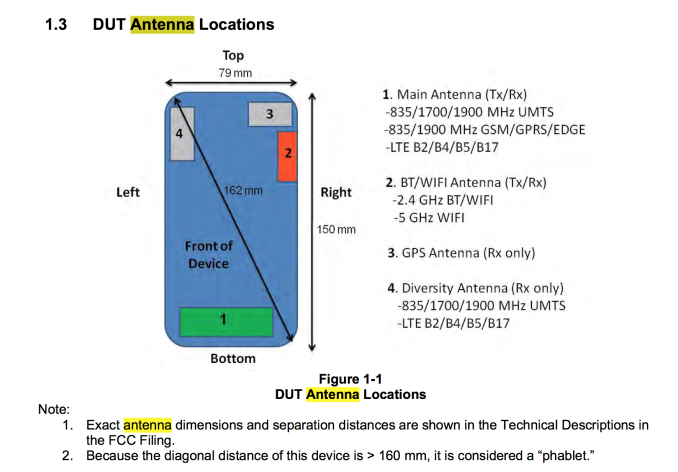
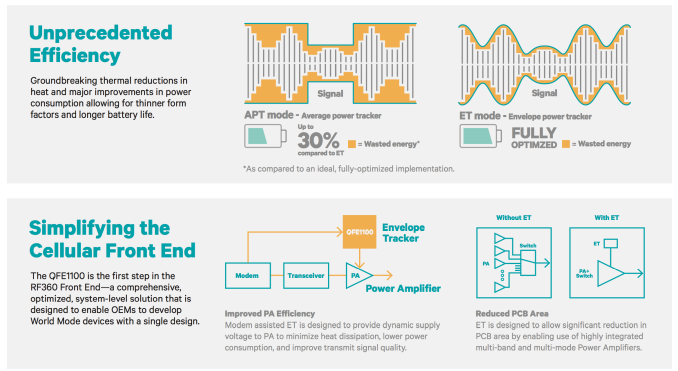
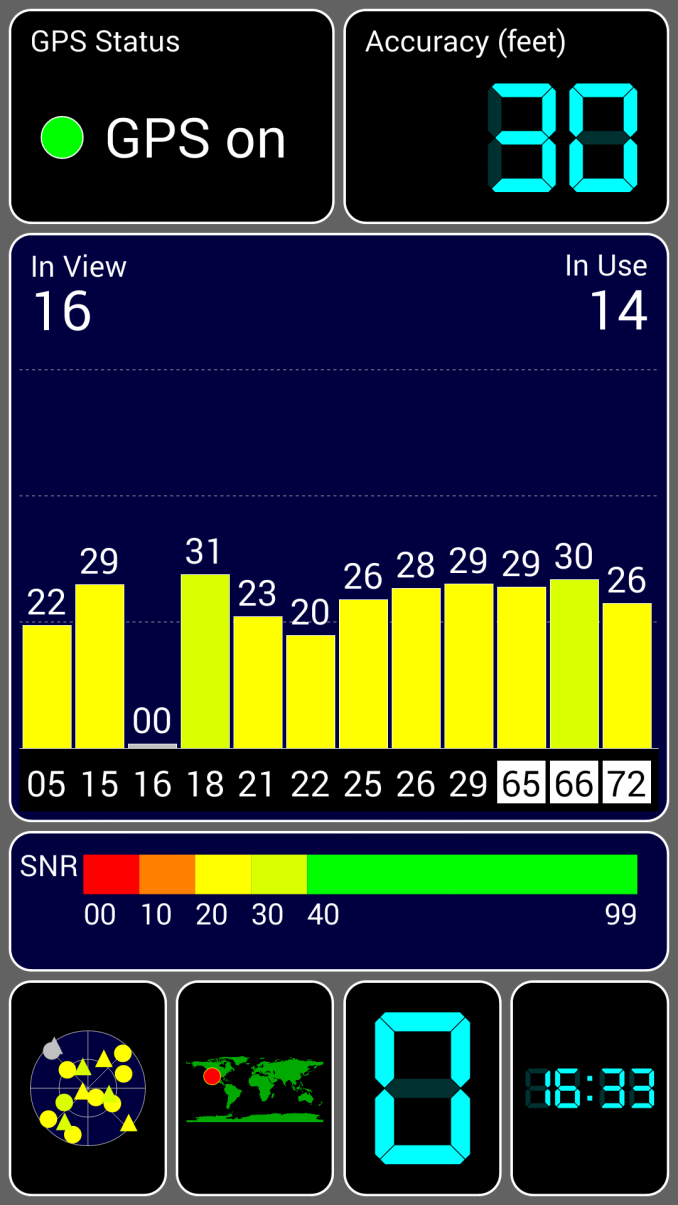
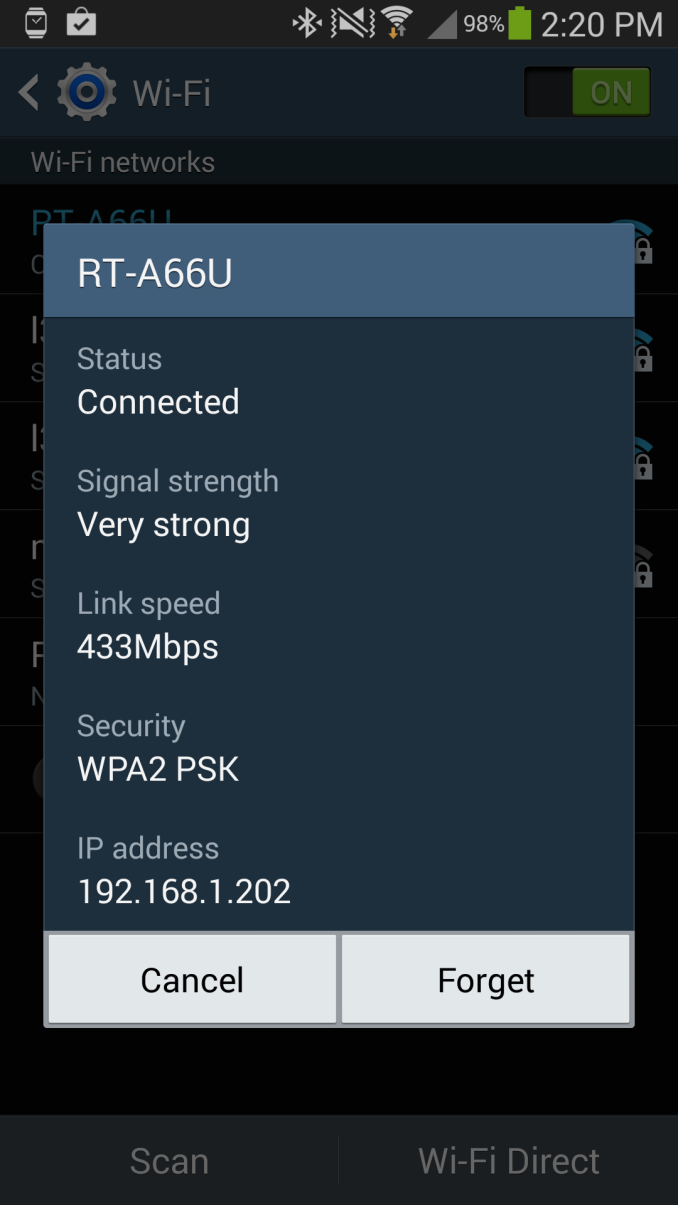
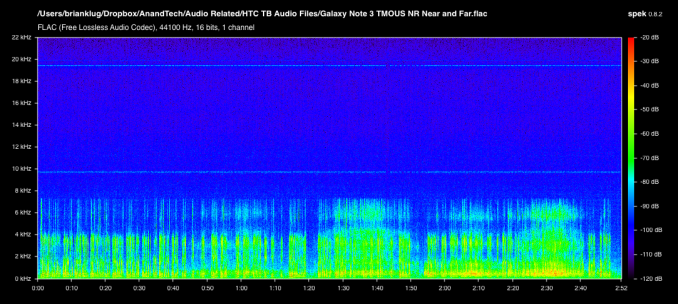








302 Comments
View All Comments
risus - Monday, October 7, 2013 - link
I agree with apiljack80. I would actually like to see this supported with options to run with different loads, throttles, and tasks to simulate different types of real work and then also a boosted all out top score.What I don't care for is that Samsung was not forthcoming with this. Had they given the user to choose profiles they would have received a whole different,and I believe, more positive response. It's the whole reason why this is being labeled a "cheat" because the technical action is not a cheat at all.
But alas this is getting so much publicity and with some other phones adopting this I think we are headed for a profile labeled benchmark anyways. Scrutiny in the mainstream tends to have it's audiences aware and vocal. But for my OC'ing (when avail for n3) I'm flipping on all cores, disable all power save, keep the thermal conservative and lets see how high we can get that bar!
AngryCTO - Thursday, October 3, 2013 - link
Besides the reviewer, how many people here actually played a bit with a Galaxy Note 3, before issuing opinions? I would advise anyone against purchasing a $650 phone without playing with it for a while. I have owned a Note 2 and felt reasonably certain to order a Note 3 without trying it in a shop before.30 minutes after I opened the box, I repackaged it and sent it back, because I find it very unpleasant to hold. Not because of the size, as some might say, but because the plastic/rubbery back feels dusty and I get the feeling I am getting my hands dirty just by holding it. The rim also feels edgy and looks like a very cheap third rate Chinese thingy. Same for the pen. People do have the touch sense too, you know. But to see what terrible crap packaging Samsung is selling, you have to open the battery compartment, at which moment all pretensions of class disappear.
The phone does feel very fast and the image quality is pretty good. The software is so bloated it is confusing to use. If they could only fix their packaging attitude to use some premium materials and streamline the software.
Until then I am buying an Xperia Z Ultra, which is cheaper but has a much better display and looks. I will be much more careful with buying Samsung from now on.
ESC2000 - Monday, October 7, 2013 - link
You do know that you can replace the back of the note III, right? You arent stuck with the fake leather back.AngryCTO - Thursday, October 3, 2013 - link
This review bothered me so much, that it looks almost like paid advertising. It is abnormal to compare the specs of Note 3 vs older Samsung phones (page 1), and not include other competing phablets, such as Sony Xperia Z Ultra, HTC Max, Nokia 1520 (which is going coming out this October). Of course, Xperia Z Ultra would wipe the floor with Note 3 with its build quality and superb glass covering, not to forget that Triluminos is the best screen technology on the market right now (and larger). This while Lumia 1520 would provide a much better and saner software experience to the overbloated TouchWiz GUI. Of course, the reviewer totally skipped the Software and User Experience part of the review, but he did compare the CPU and luminosity of such "stalwarts" like HTC One X, which is 18 months old. I could not discover in the entire review any negative comments, neither any suggestions for improvements. This phone looks perfect in the review, which is not, as I very well know after returning one. Having done my shopping research as well as possible for purchasing such an expensive phone, I would not compare a phablet with anything else but a phablet. This review is lacking competitive comparisons and relevancy.wales - Thursday, October 3, 2013 - link
Brightness Question.I've been looking for comments on this and became exhausted by the repetitive cheating discussion and gave up, so forgive me if I missed it. Brightness (or lack thereof) has always been a concern with Samsung and AMOLED displays when compared to LCDs like the HTC One, LG and IPhones. The lack of visibility outdoors in particular has been a dealbreaker for some. So I was surprised that it wasn't even mentioned in the review. Only a chart was given, showing the Note 3 well down the list at 326 nits, making it one of the only specs that may steer you away from the phone.
If that was it I'd just conclude, "ok, brightness still sucks," but a detailed display review from Displaymate comes to the opposite conclusion and touts the far superior brightness of the Note 3 compared to the Note 2. (link: http://www.displaymate.com/Galaxy_Note3_ShootOut_1... It even gets measurements of 628 nits in movie mode(!). That is a "peak brightness" measurement that Anand does not perform and may be meaningless, but the Displaymate review does note that by checking the automatic brightness box the display is capable of far higher brightness in high ambient light (i.e., sunny outdoors) environments. If true, this would largely dispel the concern with using the Note 3 outdoors, a concern reinforced by the low brightness measurement in the Anandtech review.
Anand or Brian, can you repeat the brightness measurement using automatic brightness? That would seem to be key information and potentially much more relevant than a measurement without automatic brightness checked. I understand why you would not generally take this approach, because checking auto brightness will often cap the brightness level rather than unleash it, but in this case Samsung may have reversed the approach.
If I'm off on this and Displaymate's data is wrong, my apologies.
diendanforex - Thursday, October 3, 2013 - link
The success of the Galaxy Note has increased our belief that consumers want to experience the high-quality features on the devices more intelligent and that their lives become better . Dien dan forex: http://fxvnol.comDavidjan - Thursday, October 3, 2013 - link
Cool! it must support Meenova reader to add storage like other Galaxy phone: http://goo.gl/U6IyYmeliketrolls - Friday, October 4, 2013 - link
Apple does better things than Samsung.iOS is soooo much better than Android.
josephandrews222 - Friday, October 4, 2013 - link
...all of these comments by in-hiding Apple guys are (unintentionally) revealing--the Note 3 must be, in their minds, a really good phone.Full disclosure: I do not own either an Android phone or an Apple phone
rampantarmadillo - Friday, October 4, 2013 - link
Anyone have one of these and know whether it has opengl es3 support?